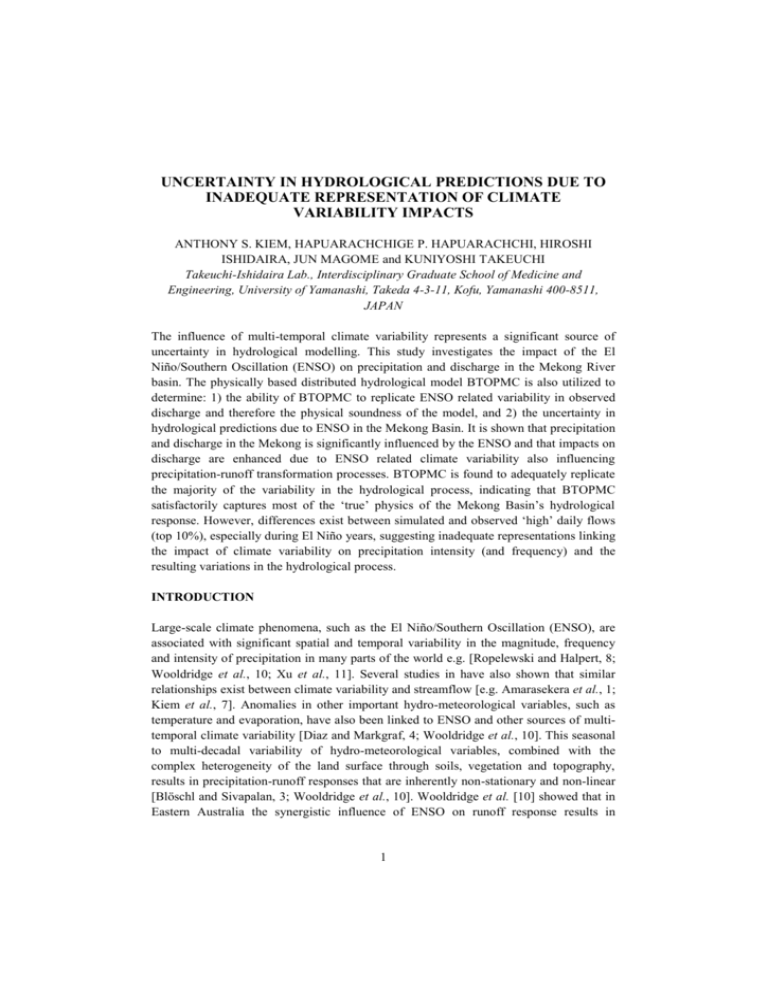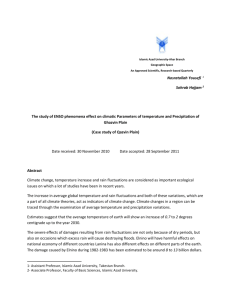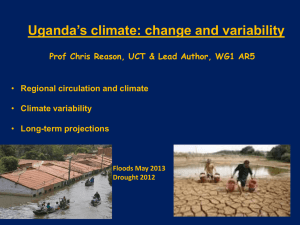56-JSC-A633
advertisement

UNCERTAINTY IN HYDROLOGICAL PREDICTIONS DUE TO INADEQUATE REPRESENTATION OF CLIMATE VARIABILITY IMPACTS ANTHONY S. KIEM, HAPUARACHCHIGE P. HAPUARACHCHI, HIROSHI ISHIDAIRA, JUN MAGOME and KUNIYOSHI TAKEUCHI Takeuchi-Ishidaira Lab., Interdisciplinary Graduate School of Medicine and Engineering, University of Yamanashi, Takeda 4-3-11, Kofu, Yamanashi 400-8511, JAPAN The influence of multi-temporal climate variability represents a significant source of uncertainty in hydrological modelling. This study investigates the impact of the El Niño/Southern Oscillation (ENSO) on precipitation and discharge in the Mekong River basin. The physically based distributed hydrological model BTOPMC is also utilized to determine: 1) the ability of BTOPMC to replicate ENSO related variability in observed discharge and therefore the physical soundness of the model, and 2) the uncertainty in hydrological predictions due to ENSO in the Mekong Basin. It is shown that precipitation and discharge in the Mekong is significantly influenced by the ENSO and that impacts on discharge are enhanced due to ENSO related climate variability also influencing precipitation-runoff transformation processes. BTOPMC is found to adequately replicate the majority of the variability in the hydrological process, indicating that BTOPMC satisfactorily captures most of the ‘true’ physics of the Mekong Basin’s hydrological response. However, differences exist between simulated and observed ‘high’ daily flows (top 10%), especially during El Niño years, suggesting inadequate representations linking the impact of climate variability on precipitation intensity (and frequency) and the resulting variations in the hydrological process. INTRODUCTION Large-scale climate phenomena, such as the El Niño/Southern Oscillation (ENSO), are associated with significant spatial and temporal variability in the magnitude, frequency and intensity of precipitation in many parts of the world e.g. [Ropelewski and Halpert, 8; Wooldridge et al., 10; Xu et al., 11]. Several studies in have also shown that similar relationships exist between climate variability and streamflow [e.g. Amarasekera et al., 1; Kiem et al., 7]. Anomalies in other important hydro-meteorological variables, such as temperature and evaporation, have also been linked to ENSO and other sources of multitemporal climate variability [Diaz and Markgraf, 4; Wooldridge et al., 10]. This seasonal to multi-decadal variability of hydro-meteorological variables, combined with the complex heterogeneity of the land surface through soils, vegetation and topography, results in precipitation-runoff responses that are inherently non-stationary and non-linear [Blöschl and Sivapalan, 3; Wooldridge et al., 10]. Wooldridge et al. [10] showed that in Eastern Australia the synergistic influence of ENSO on runoff response results in 1 2 enhanced streamflow variability when compared with the impact of ENSO on precipitation. Therefore, it is important to realize that climate variability impacts on hydrological processes are more complex than annual or seasonal precipitation averages reveal and that it is possible for discharge to be markedly influenced by climate variability, even if minimal impact is evident in the precipitation. However, significant variability also exists in the way ENSO (and also non-ENSO related variability) influences hydro-meteorological variables in space and time [e.g. Kiem et al., 7; Xu et al., 11]. Data driven and calibrated hydrological models do not adequately account for the uncertainty associated with the influence of climate variability on hydrological processes. Physically based models provide a more realistic way of approximating all the possible combinations of climatic influences (both ENSO and nonENSO related) on the hydrological process – provided they adequately capture and replicate the physical processes that contribute to the precipitation-runoff transformation and that they quantify the uncertainty associated with their predictions. This study investigates the spatial distribution of ENSO related climate variability impacts on precipitation and streamflow in the large (>550000 km2) Mekong River basin. In addition, hydrological simulations made using the physically based distributed hydrological model BTOPMC (block-wise use of TOPMODEL with Muskingum-Cunge flow routing method [Takeuchi et al., 10; Ao et al., 2] are analyzed to determine how well BTOPMC reproduces the impacts of ENSO on hydrological processes in the Mekong Basin - and therefore how well the true ‘physics’ of the basin’s precipitationrunoff relationships are captured. STUDY REGION AND DATA The Mekong River (Figure 1), starting from the Qinghai province in China and passing through Myanmar, Thailand, Laos, Cambodia and Vietnam, is the 12th longest river in the world (~ 4,800 kilometres) and the longest and most important in south-east Asia. In order to investigate the relationship between ENSO and hydrological variability in the Mekong Basin (and to calibrate and validate the BTOPMC model) daily precipitation data (1972-2000) from 64 stations throughout the Mekong basin and daily discharge data (1972-1992) at Pakse is used - this data is provided by the ‘Mekong River Commission’, ‘China Meteorological Administration’ and the ‘Institute of Atmospheric Physics at the Chinese Academy of Sciences’. Figure 1 shows the spatial distribution of the 64 precipitation stations and the location of Pakse discharge station. The upstream total drainage area of Pakse is 545000 km2 and the long-term average annual (January to December) precipitation of the basin is approximately 1570 mm. However, the actual annual averages vary significantly in space and time (see Figure 2). 3 100°0'0"E 110°0'0"E Legend ! ! ! ! $ Discharge Gauging Stations ! Precipitation Gauging Stations ! ! China 30°0'0"N 30°0'0"N ! ± ! ! ! ! ! ! Mekong Basin ! India ! ! ! ! ! ! ! ! 20°0'0"N 20°0'0"N ! ! ! ! ! ! ! ! ! ! ! ! ! ! ! ! ! ! ! ! ! ! ! ! Mukdahan ! ! ! ! ! $! ! ! ! ! ! ! ! Pakse ! ! ! $ 0 1 2 4 6 10°0'0"N 10°0'0"N ! 8 Decimal Degrees 100°0'0"E 110°0'0"E Figure 1. Location of the Mekong river basin and the discharge (Pakse) and precipitation stations used in this study Spatial distribution of precipitation in the Mekong Basin Figure 2 shows the average annual precipitation (January 1972 to December 2000) for each of the 64 precipitation stations used in this study. It can be seen that marked deviations from the annual basin average of approximately 1570 mm are apparent. The northern third of the basin is noticeably ‘drier’ (<800mm/year on average) than the long term annual basin average and the basin becomes progressively ‘wetter’ as the latitude approaches the equator, with the majority of the southern third of the basin wetter than the long term annual basin average. The ‘wettest’ area of the basin is the region around station 170406. To illustrate the temporal variability (and to further demonstrate the spatial variability) of Mekong Basin precipitation Figure 2 also displays box plots showing the monthly distributions of precipitation from January 1972 to December 2000 for six ‘representative’ stations. Although monthly distributions for only six stations are shown, these ‘representative’ stations adequately illustrate precipitation patterns of the nearby stations that have similar average annual precipitation. From the box plots in Figure 2 it can be seen that the majority of the Mekong Basin’s precipitation occurs between May and October. The large ‘boxes’ (inter-quartile ranges) and substantial differences between minimum and maximum values for the May to October monthly distributions also indicates that significant year to year variability exists during these months. 600 o o 56125 (32.2 N, 96.5 E) 400 200 600 1 2 3 4 5 6 7 8 9 10 11 12 56751 o o 56751 (25.7 N, 100.2 E) 400 200 0 1 2 3 4 5 6 7 8 9 10 11 12 0 Precipitation (mm) Precipitation (mm) 56125 Precipitation (mm) 4 600 o o 209902 (20.0 N, 99.3 E) 400 200 0 1 2 3 4 5 6 7 8 9 10 11 12 o o 209902 170406 130204 Precipitation (mm) Precipitation (mm) 170107 Precipitation (mm) 1200 170406 (18.0 N, 104.2 E) 800 400 0 1 2 3 4 5 6 7 8 9 10 11 12 600 o o 170107 (17.5 N, 101.2 E) 400 200 0 1 2 3 4 5 6 7 8 9 10 11 12 600 o o 130204 (13.7 N, 102.5 E) 400 200 0 1 2 3 4 5 6 7 8 9 10 11 12 Figure 2. Average annual (1st January 1972 to 31st December 2000) precipitation at 64 precipitation stations and monthly precipitation distributions at 6 ‘representative’ gauges (Note that the y-axis on the box plot for station 170406 has a maximum of 1200mm) ENSO IMPACTS ON PRECIPITATION AND DISCHARGE To determine the impacts of ENSO in the Mekong Basin each year is assigned an ENSO classification (either El Niño, La Niña or Neutral) based on the six-month October to March average Multivariate ENSO Index (MEI) value. This method and ENSO index has been demonstrated to be the most robust for the time period being investigated [Kiem and Franks, 6]. May to October monthly precipitation totals at each precipitation station (and monthly discharge totals at Pakse) are then stratified into El Niño, La Niña and Neutral phases based on the ENSO classification for the relevant year. Stratified precipitation (and discharge) totals for each month (May to October) at each gauge are then compared to determine the relationship between different ENSO phases and precipitation (and discharge). The ENSO analysis is only performed from May to October as Figure 2 shows that minimal annual variation occurs in the precipitation totals during the Mekong Basin ‘dry’ season (November to April). Therefore, it is assumed (and has been confirmed by the authors) that the impacts of ENSO on hydro-climatic data in the Mekong Basin ‘dry’ season are also minimal. 600 o o 56125 (32.2 N, 96.5 E) 400 200 600 o 200 0 5e 5n 6e 6n 7e 7n 8e 8n 9e 9n 10e 10n 5e 5n 6e 6n 7e 7n 8e 8n 9e 9n 10e 10n 56751 o 56751 (25.7 N, 100.2 E) 400 0 Precipitation (mm) Precipitation (mm) 56125 Precipitation (mm) 5 600 o o 209902 (20.0 N, 99.3 E) 400 200 0 5e 5n 6e 6n 7e 7n 8e 8n 9e 9n 10e 10n o o 209902 170406 130204 Precipitation (mm) Precipitation (mm) 170107 (white circle) (white circle) Precipitation (mm) 1200 170406 (18.0 N, 104.2 E) 800 400 0 5e 5n 6e 6n 7e 7n 8e 8n 9e 9n 10e 10n 600 o o 170107 (17.5 N, 101.2 E) 400 200 0 5e 5n 6e 6n 7e 7n 8e 8n 9e 9n 10e 10n 600 o o 130204 (13.7 N, 102.5 E) 400 200 0 5e 5n 6e 6n 7e 7n 8e 8n 9e 9n 10e 10n Figure 3. Ratio of mean non-El Niño to mean El Niño May to October precipitation totals and monthly (May to Oct.) precipitation distributions during El Niño (e) and non-El Niño (n) at 6 ‘representative’ gauges. (Note: y-axis for station 170406 has a max. of 1200mm) It was found that no significant difference existed between the precipitation (and discharge) in the La Niña and Neutral phases and therefore these two groups were combined to form a ‘non-El Niño’ group. Figure 3 shows the ratio of mean non-El Niño to mean El Niño May to October total precipitation. A ratio of greater than one indicates that non-El Niño events are ‘wetter’ than El Niño years. In addition, for the stations with a ratio greater than one a Students t-test is performed to determine if the increase in precipitation during non-El Niño years is significant. A p-value of less than 0.1 (the <10% level) is considered to indicate a statistically significant increase. From Figure 3 it can be seen that the average May to October precipitation is higher during non-El Niño years for the majority (57 out of 64) of stations, and that for 26 stations this difference is significant at the <10% level. Figure 3 also shows the monthly distributions (May to October) for the six ‘representative’ stations. The important point to gain from these box plots is that even though the tendency is for El Niño months to be ‘drier’ than the same months occurring in non-El Niño years there is still marked variability within El Niño and non-El Niño distributions – even for stations where a significant difference between mean El Niño and mean non-El Niño May to October totals exists. This suggests that non-ENSO related climate variability also plays an important role in the Mekong Basin. 6 1050 1000 950 900 (a) 2.5 2 n Qobs 1.5 (b) 0.45 n 0.4 en 0.35 0.3 (c) Figure 4. El Niño and non-El Niño distributions of May to October (a) basin average precipitation, (b) observed discharges at Pakse and (c) runoff ratios. 1.1 1 0.9 (a) 0.8 0.7 El Nino non-El Nino 8 7 en Qsim 3 n 0.5 o Pakse (15.1 N, 105.8 E) 6 en Qobs 4 en en Qobs 1.2 5 n Qsim 4 n Qobs Discharge (x10 m /s) 1150 3 o 0.55 Ratio of Simulated/Observed May to Oct Total Discharge 11 1200 1100 3.5 3 1250 May to Oct Total ObsQ/Basin Av. P 1300 May to Oct Total Q (x10 m /s) Basin Av. May to Oct Total P(mm) Figure 4a illustrates the impacts that ENSO has on May to October total precipitation averaged over the whole Mekong Basin while Figures 4b and 4c demonstrate the impact that ENSO has on discharge at Pakse. The mean basin average May to October total precipitation is 8% higher in non-El Niño years than it is for El Nino (this difference is significant at the <5% level). However, when the observed average May to October total discharge at Pakse is analyzed it is found that non-El Niño years are on average more than 16% wetter than El Nino (also significant at the <5% level). Figure 4c shows that this enhancement of ENSO influences on discharge when compared to precipitation is because the runoff ratio during non-El Niño years is higher (~8%) than it is during El Niño. This implies that, in addition to the precipitation in non-El Niño events tending to be higher than El Niño, a given unit of precipitation will result in much more discharge during the non-El Niño phase. This result demonstrates that ENSO influences both precipitation and the processes controlling the precipitation-runoff transformation in the Mekong Basin. The question is how well does the physically based distributed hydrological model BTOPMC replicate this ENSO related variability? 3 2 1 0 .01 .1 (b) 1 5 10 20 50 70 Percent 90 95 99 99.9 Figure 5. El Niño and non-El Niño (a) distributions of the ratio of simulated to observed May to October total discharge, (b) probability distributions of the daily observed and simulated discharge between May and October at Pakse HYDROLOGICAL SIMULATIONS FOR THE MEKONG USING BTOPMC Simulated daily discharge at Pakse is obtained for the same period as the observed discharge data (1972-1992) using the latest version of BTOPMC [Takeuchi et al., 10; Ao et al., 2]. The updated version of BTOPMC incorporates a new approach to estimate lateral transmissivity of soil (T0) which eliminates the need for subjective soil reclassification methods and more accurately approximates the true physical characteristics of the catchment [Hapuarachchi et al., 5]. Overall model evaluation statistics indicate that BTOPMC adequately simulates the observed discharge at Pakse. The Nash-Sutcliffe coefficient equals 82.7% for the 1972-77 calibration period and 81.7% for the 1978-1992 validation, while the simulated to observed discharge ratio 7 equals 1.016 for calibration and 1.02 for validation. However, of greater interest for this study is how well BTOPMC replicates the ENSO related variability evident in the Mekong Basin – and therefore how well the actual physical processes contributing to hydrological variability are represented. This is assessed by stratifying the simulated discharge into ENSO groups and comparing the May to October El Niño and non-El Niño distributions with each other and with the ENSO-stratified observed discharge distributions to determine whether the distinct El Niño and non-El Niño responses are reproduced. When the simulated El Niño and non-El Niño distributions of May to October totals are compared it is found that the differences between the two is very similar to the differences in the observed data with Figure 5a showing that the majority of simulated May to October totals are less than 5% (10%) higher or lower than observed for non-El Niño (El Niño) years. The simulated average May to October total discharge during nonEl Niño years is approximately 14% wetter than El Nino (compared with 16% for the observed data) and as with the observed data this difference is also significant at the <5% level. However, when the daily simulated and observed discharges are compared for the El Niño and non-El Niño groups it is found that some discrepancies exist. The NashSutcliffe coefficient calculated only on daily values from May to October in El Niño years is only 63% compared with 76% for non-El Niño events indicating that even though the May to October total discharge is reasonably well reproduced in all ENSO phases some problems exist at the daily scale, especially during El Niño years. Figure 5b shows that the probability distributions of the daily observed and simulated discharge between May and October are well matched up to the 90 th percentile. However, for discharges in the top 10th percentile the simulated and observed probability distributions begin to diverge markedly, especially for El Niño events. Figure 5b (and the low NashSutcliffe coefficient for El Niño years) indicates that BTOPMC has some problems replicating the precipitation-runoff processes that control the timing and magnitude of high flow events, particularly in El Niño years. CONCLUSIONS Precipitation and discharge in the Mekong is significantly influenced by the ENSO, with mean basin average precipitation (discharge at Pakse) approximately 8% (16%) higher during non-El Niño years. Results indicate that enhancement of ENSO impacts on discharge is due to ENSO related climate variability also influencing the processes controlling the precipitation-runoff transformation in the Mekong Basin. BTOPMC adequately replicates the majority of ENSO related variability in the hydrological process, indicating that BTOPMC satisfactorily captures most of the ‘true’ physics of the Mekong Basin’s hydrological response. However, differences exist between simulated and observed high daily flows (top 10%), especially during El Niño years. This indicates that the processes associated with generating peak flows are not well represented in BTOPMC. Preliminary investigations suggest the impact of climate variability on 8 precipitation frequency and intensity and the resulting variation in canopy interception and infiltration excess is inadequately represented. It is also important to note that the climate related variability in precipitation, discharge and hydrological processes illustrated in this study is extremely difficult to replicate in a hydrological model that is not physically based. As shown here, and in previous studies [e.g. Kiem et al., 7], the impacts of ENSO vary markedly from event to event and also on decadal-multi-decadal time-scales. There is also non-ENSO related variability to consider along with the possibility that the frequency and magnitude of climate impacts could change in the future. Therefore, to adequately approximate and replicate all possible hydrological responses with a non-physical based model would require extensive data records in order to calibrate or ‘train’ the model how to perform – even then an event or combination of events may occur that did not occur in the calibration data period, resulting in inaccurate hydrological simulations. Identification of the physical mechanisms which cause non-stationary and non-linear precipitation-runoff relationships, and the incorporation of this insight into physically based hydrological models, is crucial for successful prediction in ungauged basins. If the processes which cause climate related variations in the precipitation-runoff relationship can be identified, and adequately approximated via physically based model parameters, then the uncertainty associated with predicted discharges when these models are applied to ungauged basins will be significantly reduced, especially for areas where the influence of climate variability is marked. REFERENCES [1] Amarasekera, K.N., Lee, R.F., Williams, E.R. and Eltahir, E.A., “ENSO and the natural variability in the flow of tropical rivers”, J. Hydrology, Vol. 200, No. 1, (1997), pp 24-39. [2] Ao, T.Q., Yoshitani, J., Takeuchi, K., Fukami, K., Mutsuura, T. and Ishidaira, H., “Effects of sub-basin scale on runoff simulation in distributed hydrological model: BTOPMC”, in “Weather Radar Information and Distributed Hydrological Modeling” (Proc. HS03 held at IUGG2003), Sapporo, (2003), pp 227-233. [3] Blöschl, G. and Sivapalan, M., “Scale issues in hydrological modelling: a review” in “Scale issues in hydrological modelling”, (Eds: Kalma, J.D. and Sivapalan, M.), John Wiley & Sons Ltd, (1995), pp 9-48. [4] Diaz, H.F. and Markgraf, V.E., “El Niño and the Southern Oscillation, Multiscale Variability and Global and Regional Impacts.” Cambridge University Press, (2000). [5] Hapuarachchi, H.P., Kiem, A.S., Ishidaira, H., Magome, J. and Takeuchi, K., “Eliminating uncertainty associated with classifying soil types in distributed hydrological modeling”, Proc. Joint AOGS 1st Annual Meeting & 2nd APHW Conference, Singapore, (2004), (in press). 9 [6] Kiem, A.S. and Franks, S.W., “On the identification of ENSO-induced rainfall and runoff variability: a comparison of methods and indices”, Hydrol. Sci. J., Vol. 46, No. 5, (2001), pp 715-727. [7] Kiem, A.S., Franks, S.W. and Kuczera, G., “Multi-decadal variability of flood risk”, Geophys. Res. Lett., Vol. 30, No. 2, (2003), pp 1035, doi:10.1029/2002GL015992. [8] Ropelewski, C.F. and Halpert, M.S., “Quantifying Southern Oscillation Precipitation Relationships”, J. Climate, Vol. 9, No. 5, (1996), pp 1043-1059. [9] Takeuchi, K., Ao, T.Q. and Ishidaira, H., “Introduction of block-wise use of TOPMODEL and Muskingum-Cunge method for the hydro-environmental simulation of a large ungauged basin”, Hydrol. Sci. J., Vol. 44, No. 4, (1999), pp 633-646. [10] Wooldridge, S.A., Franks, S.W. and Kalma, J.D., “Hydrological Implications of the Southern Oscillation: variability of the rainfall - runoff relationship”, Hydrol. Sci. J., Vol. 46, No. 1, (2001), pp 73-88. [11] Xu, Z.X., Takeuchi, K. and Ishidaira, H., “Correlation between El Niño-Southern Oscillation (ENSO) and precipitation in South-east Asia and the Pacific region”, Hydrol. Proc., Vol. 18, No. 1,(2004), pp 107-123.








